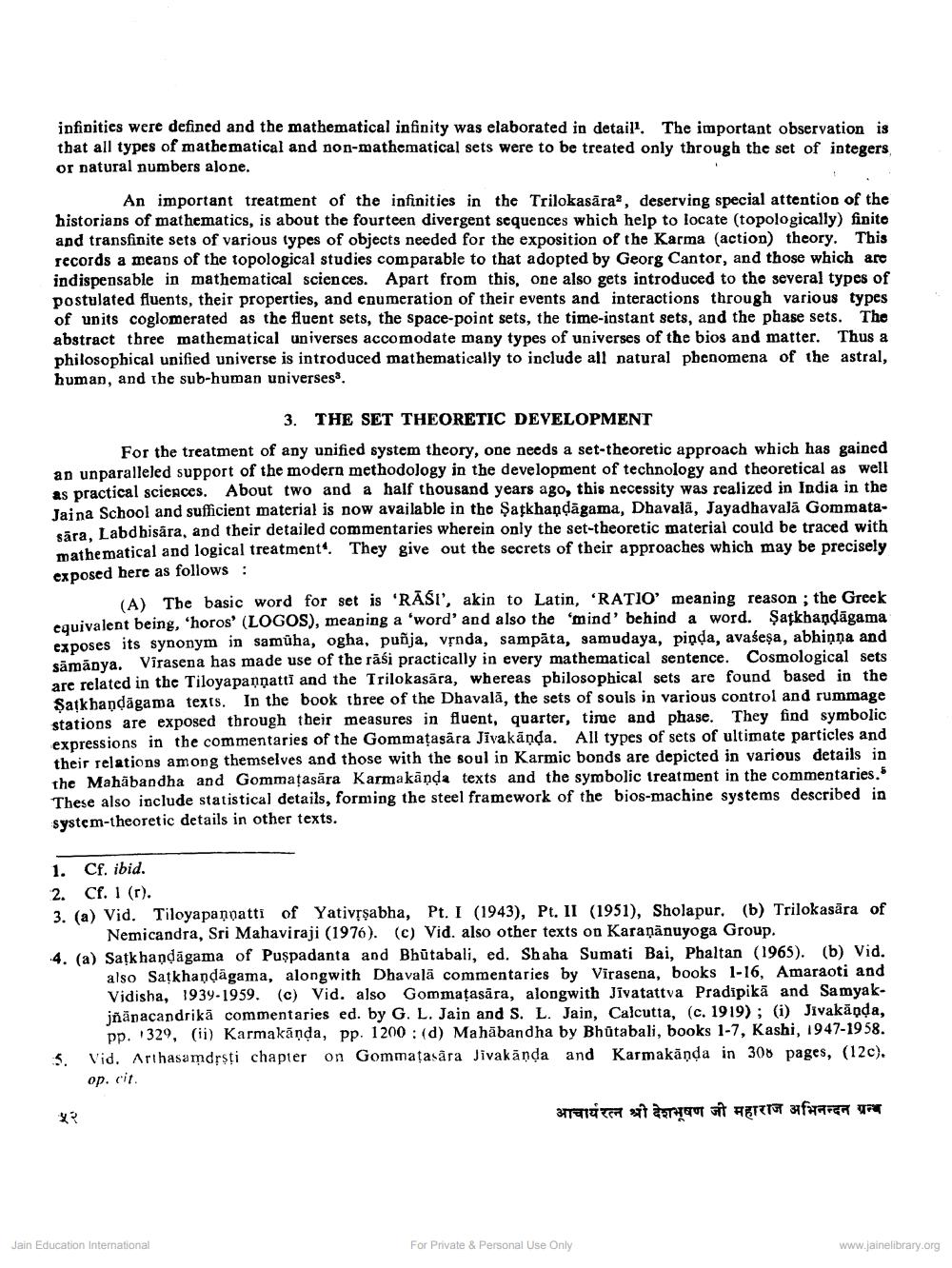Book Title: Jaina Ulterior Motive of Mathematical Philosophy Author(s): L C Jain, C K Jain Publisher: Z_Deshbhushanji_Maharaj_Abhinandan_Granth_012045.pdf View full book textPage 4
________________ infinities were defined and the mathematical infinity was elaborated in detaill. The important observation is that all types of mathematical and non-mathematical sets were to be treated only through the set of integers, or natural numbers alone. An important treatment of the infinities in the Trilokasāra, deserving special attention of the historians of mathematics, is about the fourteen divergent sequences which help to locate (topologically) finito and transfinite sets of various types of objects needed for the exposition of the Karma (action) theory. This records a means of the topological studies comparable to that adopted by Georg Cantor, and those which are indispensable in mathematical sciences. Apart from this, one also gets introduced to the several types of postulated fluents, their properties, and enumeration of their events and interactions through various types of units coglomerated as the fluent sets, the space-point sets, the time-instant sets, and the phase sets. The abstract three mathematical universes accomodate many types of universes of the bios and matter. Thus a philosophical unified universe is introduced mathematically to include all natural phenomena of the astral, human, and the sub-human universes 3. THE SET THEORETIC DEVELOPMENT For the treatment of any unified system theory, one needs a set-theoretic approach which has gained an unparalleled support of the modern methodology in the development of technology and theoretical as well as practical sciences. About two and a half thousand years ago, this necessity was realized in India in the Jaina School and sufficient material is now available in the Satkhandägama, Dhavajā, Jayadhavala Gommatasára, Labd hisára, and their detailed commentaries wherein only the set-theoretic material could be traced with mathematical and logical treatment. They give out the secrets of their approaches which may be precisely exposed here as follows: (A) The basic word for set is 'RĀSI', akin to Latin, "RATIO' meaning reason; the Greek equivalent being, 'horos' (LOGOS), meaning a 'word' and also the 'mind' behind a word. Şarkhandägama exposes its synonym in samüha, ogha, puñja, vsnda, sampāta, samudaya, pinda, avašesa, abhinna and sāmāpya. Virasena has made use of the răsi practically in every mathematical sentence. Cosmological sets are related in the Tiloyapannatti and the Trilokasära, whereas philosophical sets are found based in the Satkhandägama texts. In the book three of the Dhavalā, the sets of souls in various control and rummage stations are exposed through their measures in fluent, quarter, time and phase. They find symbolic expressions in the commentaries of the Gommațasara Jivakānda. All types of sets of ultimate particles and their relations among themselves and those with the soul in Karmic bonds are depicted in various details in the Mahabandha and Gommatasära Karmakānda texts and the symbolic treatment in the commentaries. These also include statistical details, forming the steel framework of the bios-machine systems described in system-theoretic details in other texts. 1. Cf. ibid. 2. Cf. 1 (r). 3. (a) Vid. Tiloyapaņoatti of Yativrşabha, Pt. I (1943), Pt. II (1951), Sholapur. (b) Trilokasära of Nemicandra, Sri Mahaviraji (1976). (c) Vid. also other texts on Karaņānuyoga Group. 4. (a) Satkhandāgama of Puşpadanta and Bhūtabali, ed. Shaha Sumati Bai, Phaltan (1965). (b) Vid. also Satkhandāgama, alongwith Dhavalā commentaries by Virasena, books 1-16, Amaraoti and Vidisha, 1939-1959. (c) Vid. also Gommatasāra, alongwith Jivatattva Pradipikā and Samyakjñānacandrikā commentaries ed. by G. L. Jain and S. L. Jain, Calcutta, (c. 1919); (i) Jivakā da, pp. 329, (ii) Karmakāņda, pp. 1200 : (d) Mahābandha by Bhutabali, books 1-7, Kashi, 1947-1958. 5. Vid. Arthasamdrsti chapter on Gommațasara Jivakānda and Karmakānda in 300 pages, (12c). op. cit. आचार्यरत्न श्री देशभूषण जी महाराज अभिनन्दन ग्रन्थ Jain Education International For Private & Personal Use Only www.jainelibrary.orgPage Navigation
1 2 3 4 5 6 7 8 9 10 11
